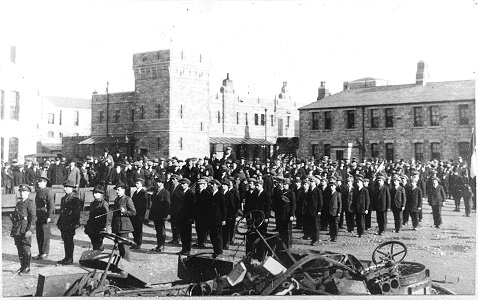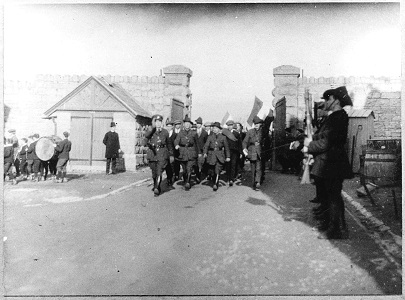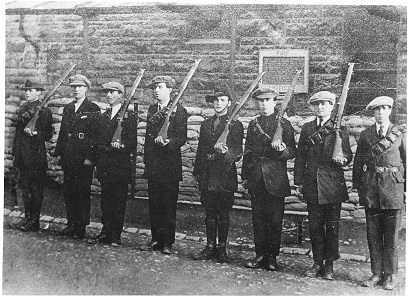THE CHANGING OF THE GUARD

by Tom Kenny
On this day, February 13th, 1922, the I.R.A. took over Renmore Barracks from the British. When the Anglo-Irish Treaty was ratified on January 7th 1922 ,it was only a matter of time before the British Army would leave the Barracks. There was some suggestion initially that the regional Hospital might transfer to the barracks. On February 2nd, the last Black and Tans had left Galway by train. The British did not want to surrender the Barracks to the Volunteers, so an arrangement was made where they would leave at a certain time, and the formal handover wold take place a few hours later.
The Irish officer assigned for the take-over was Captain Stephen Rynne formerly of the Dublin Brigade of the I.R.A. By the time he entered the premises, the locals had stripped the barracks of most of the furniture. Two Volunteers, John Murphy and Sonny King raised a large tricolour. An advance guard arrived to replace the military sentries and are seen in our first photograph. They are, from the left, Henry Lynch, John Bannigan, John Canavan, Patrick White, Michael Francis, Joseph Kelly, Patrick Feeney and Sergeant Thomas Kelly.
Later, 22-year old Commandant Seán Broderick from Prospect Hill, took charge of 250 members of A, B and D Company of the 4th Battalion of the Volunteers, and headed by the Salthill Industrial School Band who played ‘national airs, they marched into the barracks. A Company was made up of Volunteers from the heart of the town from the Claddagh to Eyre Square; B Company were mostly from the Bohermore, Prospect Hill and Woodquay areas; D Company were from the Western suburbs. Our photograph shows Seán Broderick and IRA officers leading the Volunteers in. Some of the Industrial School band can be seen on the left.

The battalion, who were not yet fully equipped with uniforms, was marched to the parade ground where several manoeuvres were gone through. Divisional Commissioner Brennan arrived and inspected the battalion and inspected the building. Our third image (taken by Bertie Simmons) shows these troops of the new Irish Free State Army on parade.
The Connacht Tribune reported ‘scenes of great enthusiasm as the boys were warmly cheered and there were shouts of Fáilte’. “How few Irishmen, even amongst what is, perhaps erroneously sometimes described as “the extreme section” thought they would ever live to see the day when British troops wold voluntarily evacuate Renmore depot and an Irish civilian army would march in to take possession of it? Yet so history was made in Galway on Monday. We wonder how many of those who witnessed A. B. and D. Companies of the 4th Battalion IRA marching to Renmore to the music of Industrial School boys realised the full significance of the event. In three words it meant that Ireland is free.

